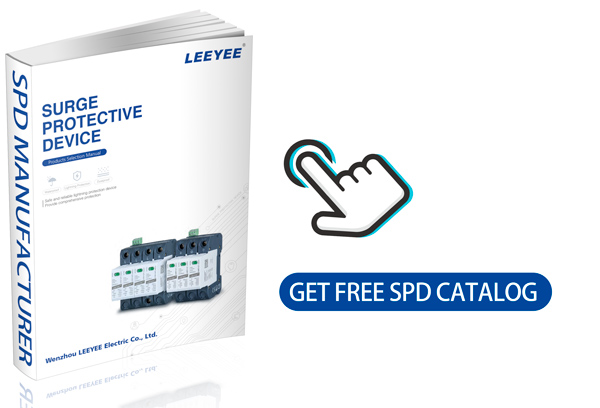Technical Analysis & Selection Guide for Power Industry Professionals
Unexpected voltage spikes—whether caused by lightning, capacitor bank switching, or motor restarts—can result in permanent damage to power infrastructure and connected equipment. In solar fields, industrial plants, or data facilities, this means downtime, fire hazards, and major capital loss. The solution is an engineered surge protection strategy. LEEYEE, a certified manufacturer in the surge protection field, provides Type 1, Type 2, and Type 3 SPD solutions with CE, CB, ISO9001, and TUV certifications. Designed for AC and DC systems (up to 1500VDC), LEEYEE SPDs deliver up to 100kA discharge capacity with response times under 25ns—performance that ranks in the top tier of global SPD suppliers.
Surge protectors limit transient overvoltages by diverting surge energy to ground within nanoseconds, ensuring safety and continuity in critical power systems.
Proper SPD selection and coordination is vital to avoid failure, nuisance tripping, or regulatory non-compliance. Let’s explore in detail.
Table of Contents
Surge Protection Basics – What Do Surge Protectors Really Do?
A surge protection device (SPD) operates by clamping and redirecting transient overvoltages—often in the form of thousands of volts over microseconds. According to IEC 61643-11, an SPD must respond quickly (typically <25ns) and handle specified surge energy (measured in kA) without failure.
In electrical power systems, the following types are typically deployed:
-
Type 1 SPD: For direct lightning strikes (Class I), often installed at service entrances or in lightning-prone areas.
-
Type 2 SPD: For switching surges and indirect lightning (Class II), used in distribution panels and PV systems.
-
Type 3 SPD: For point-of-use protection (Class III), applied near sensitive electronics.
Where Surge Protection is Mandatory
Surge protectors are required by codes like IEC60364-4-44, especially where:
-
Risk of lightning is high (Level LPL I-II)
-
Loss of human life, essential services, or economic data is possible
-
PV systems exceed 600VDC (typically require Type 2 or hybrid SPD)
-
Electrical loads involve VFDs, elevators, or motor-driven systems
LEEYEE SPD Technical Parameters
| Parameter | Value Range |
|---|---|
| Max Continuous Operating Voltage (Uc) | 275V–1500V AC/DC |
| Nominal Discharge Current (In) | 20kA–40kA |
| Maximum Discharge Current (Imax) | Up to 100kA |
| Voltage Protection Level (Up) | <1.8kV (Class II), <2.5kV (Class I) |
| Response Time | <25ns |
| Standards | IEC61643-11, EN50539, GB18802 |
| Certifications | CE, CB, ISO9001, TUV |
| Safety Features | Thermal disconnector, fault indicator |
LEEYEE SPDs are modular, DIN-rail mountable, and available in single-phase, three-phase, or multi-MPP (PV) configurations.
Application Engineering: How to Configure SPDs
For AC Power Distribution Systems:
-
TN-S/TN-C-S System: Use 4P Type 2 SPD (e.g., LEEYEE model 40kA@275V AC)
-
TT Systems: Require additional N-PE protection module
-
Coordination with MCB/Backup Fuse: SPD must be coordinated with upstream short-circuit protection as per manufacturer’s Icc rating
For PV Systems:
-
1000VDC & 1500VDC: Use PV SPD with VPR <3kV, In ≥ 20kA
-
String Protection: Install SPD at inverter DC input, combiner box, and array level
-
Reverse Polarity Protection: LEEYEE PV SPDs include varistor + GDT hybrid modules with non-polarized design
Field Integration: How LEEYEE Adds Value
LEEYEE not only supplies SPDs, but also offers full integration support:
-
OEM/ODM Branding with laser or screen-print logo
-
Custom housing color or enclosure IP rating (IP20–IP65)
-
Factory inspection reports, 3rd-party certificate scans, and PICC quality guarantee
-
On-request: I-V curve testing, UL94-V0 flame retardant compliance, remote fault alarm output
FAQs – What Do Surge Protectors Do?
1. What’s the difference between Type 1 and Type 2 SPD?
Type 1 handles direct lightning current (10/350µs waveform), Type 2 is for surge voltages from switching or indirect lightning (8/20µs).
2. How do I select SPD current rating (In/Imax)?
Base it on risk assessment, lightning density (Ng), building height, and system exposure.
3. Can I use one SPD for both AC and DC?
No. Use AC-specific and DC-rated SPDs separately. LEEYEE provides dedicated models for both.
4. Does an SPD need periodic replacement?
Yes. If the MOV is thermally disconnected or indicator is red, replace it. Also consider end-of-life cycle ~5 years in surge-prone zones.
5. Can I use SPD without MCB?
Only if integrated protection is built-in. LEEYEE recommends coordination with certified MCBs or gG backup fuses.
6. Are LEEYEE SPDs compliant with EU solar codes?
Yes. Our PV SPDs conform to EN50539-11 and IEC 61643-31, suitable for European utility projects.
7. How does SPD affect insulation coordination?
It lowers transient voltages below the Basic Insulation Level (BIL), ensuring dielectric protection of system components.
⚠️ Disclaimer
This article is for qualified industry professionals and system designers. Always refer to local electrical codes and consult a certified engineer for installation, surge risk analysis, and SPD coordination.

